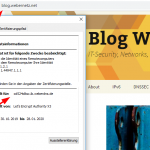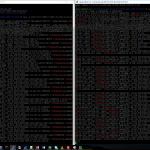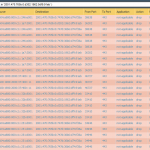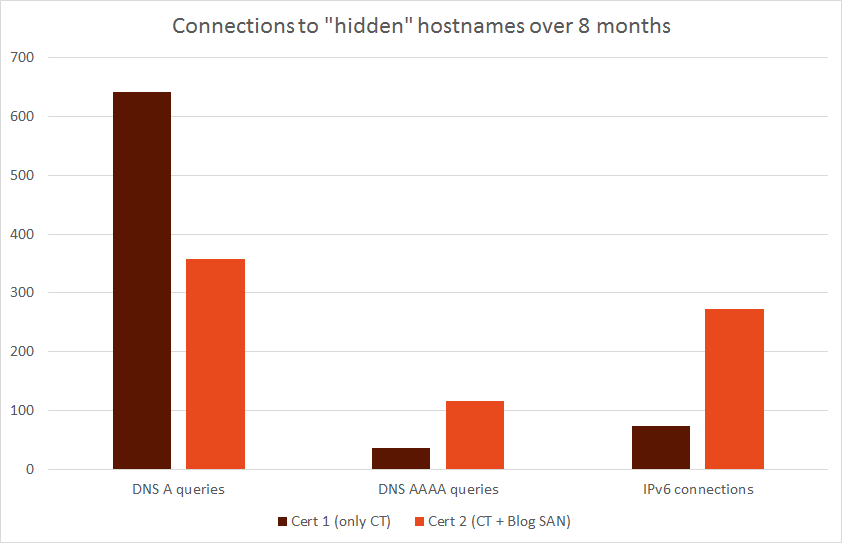Maybe you’ve heard of Certificate Transparency and its log. Citing Wikipedia: “Certificate Transparency (CT) is an Internet security standard and open source framework for monitoring and auditing digital certificates.” Basically, it gives you information about any public certificate that is issued. Besides its advantages, I thought of one possible problem as it leaks all FQDNs to the public when using TLS certificates, for example from Let’s Encrypt.
A similar problem might arise when using a single X.509 certificate with a couple of DNS names (subject alternative name SAN) from which one should be kept “private”. It will be publicly known as well.
Hence I made a self-experiment in which I generated two certificates with random names, monitoring the authoritative DNS servers as well as the IPv6 addresses of those names in order to check who is resolving/connecting to otherwise unknown hostnames. Here we go:
The Setup
I used randomly generated hostnames and IPv6 addresses:
- A Let’s Encrypt certificate with a single DNS name which I have never used anywhere. I didn’t even google for it or the like. Its name is 7qftpqiw5m.ib.weberdns.de having a single AAAA record pointing to 2001:470:765b:0:747d:36b6:0d74:f26a. Issued at 2019-10-30 14:49 UTC, CT log here: https://crt.sh/?id=2053680948.
- Another LE certificate with a DNS name of xd524olksc.ib.weberdns.de (with AAAA to 2001:470:765b:0:d302:1962:0df9:91eb) along with weberblog.net and blog.webernetz.net (my old hostname for the blog). In fact, I used this certificate for 2,5 months on my blog itself, giving many entities the possibility to see the hostname. Issued at 2019-10-30 15:09 UTC, CT log here: https://crt.sh/?id=2053730087. It was active on my blog until 2020-01-15 13:55 UTC.
As both certificates were issued by Let’s Encrypt, their validity expired after 90 days.
Since I am controlling the authoritative DNS servers for *.ib.weberdns.de (Infoblox VMs with query logging enabled) as well as the IPv6 space 2001:470:765b::/64 (a HE tunnel broker connection through my Palo Alto Networks firewall) I was able to catch every single DNS query and IP connection attempt. ;) However, all connections were blocked completely. No service was listening on those IPv6 addresses at all.
Many DNS Queries and IP Connections
After the two certificates were issued, I put the second one (with the SAN) on my blog. For both hostnames, I saw a couple of DNS requests on the DNS servers immediately. As well as incoming connections to the IPv6 addresses:
Here is a screenshot from the Palo Alto, showing the two blocking rules and their hits:
My Analysis
I grepped through the log files from the authoritative DNS servers as well as from the firewall. As expected, there are hundreds of connection attempts to both hostnames:
| Cert 1 only CT | Cert 2 CT + Blog SAN |
|
|---|---|---|
| DNS queries for A (unique sources) | 642 (307) | 357 (228) |
| DNS queries for AAAA (unique sources) | 37 (32) | 117 (99) |
| DNS queries for CAA (unique sources) | 3 (3) | 24 (14) |
| All queried RRs | 642 A 37 AAAA 22 MX 6 DS 5 NS 3 TXT 3 SOA 3 CAA 2 CNAME | 357 A 117 AAAA 29 MX 24 CAA 8 TXT 8 NS 7 SOA 4 DS 3 CNAME 2 DNSKEY |
| IPv6 connections (unique sources) [unique /32] | 73 (15) [2] | 273 (46) [14] |
| Destination Ports | 73x 443 | 154x 80 122x 443 |
| Sourcing ASes | 14 DigitalOcean, LLC 1 Google LLC | 14 DigitalOcean, LLC 8 Quintex Alliance Consulting 6 Emerald Onion 4 Google LLC 4 F3 Netze e.V. 2 Zwiebelfreunde e.V. 2 Nexeon Technologies, Inc. 1 OVH Ltd 1 Keyweb AG 1 Joey Julian Koenig 1 Hydra Communications Ltd 1 Hurricane Electric LLC 1 Alec Larsen |
Q.E.D.
While the first FQDN got more DNS queries, the second one received much more connection attempts.
I have not looked into every single IPv6 source address, but there seem to be some interesting ones. Of course, it’s Google. And quite often DigitalOcean which probably only hosts some kind of stuff? (Does anyone know where Let’s Encrypt itself is hosted?) Furthermore, at least one Tor exit node is present according to the whois search. And Technische Universitaet Muenchen querying the CAA records of the hostname just a few seconds after it appeared in the CT log. Probably some research going on here? Same for Cloudflare, which only queried the CAA record.
Further Analysis
As always, you could do so much more with this data. At first, drawing some more nice graphs to have an easier understanding of the data than the raw values. ;) But also some more analysis such as:
- timeline of queries <- this would probably reveal much more queries in the first few hours compared to the rest of the test period
- correlation of the DNS clients (that sent the DNS query) and the IPv6 addresses that sourced actual connections to the servers <- probably no big correlation here since the first show the recursive DNS resolvers while the second the Google crawlers
- a deeper look at the source IPv6 addresses <- more details about search engine crawlers, university projects, TOR exit nodes, and random private clicks as someone saw the weird hostname on my blog’s certificate.
Conclusion
My analysis used only IPv6 addresses behind those hostnames. Since the query rate for A records was much higher, it is likely that there are a couple of hundred connection attempts for every hostname that ever appeared in the public CT logs or that is just a subject alternative name on a publicly used certificate.
Appendix
If you want to have a look at the raw logs, here we go:
I used the following shell commands for my analysis (refer to Logfile Parsing):
|
1 2 3 4 5 6 7 8 9 10 11 12 13 14 15 16 17 18 19 20 21 22 23 24 25 26 27 28 29 30 31 32 33 34 35 36 37 38 39 40 41 42 43 |
#both DNS names from both authoritative DNS servers cat /var/log/firewalls/2001:470:765b::d031:53/*/*/* | grep 7qftpqiw5m > ~/cert1-dns-ib1 cat /var/log/firewalls/2001:470:765b::d031:53/*/*/* | grep xd524olksc > ~/cert2-dns-ib1 cat /var/log/firewalls/2001:470:1f0b:16b0::d032:53/*/*/* | grep 7qftpqiw5m > ~/cert1-dns-ib2 cat /var/log/firewalls/2001:470:1f0b:16b0::d032:53/*/*/* | grep xd524olksc > ~/cert2-dns-ib2 #both policy logs cat /var/log/firewalls/2001:470:765b::1/*/*/* | grep 2867f699-8191-4169-98ae-d45d7f349c29 > ~/cert1-palo cat /var/log/firewalls/2001:470:765b::1/*/*/* | grep 151bf66d-2f75-43ab-b8ec-9dcc14f51fac > ~/cert2-palo #both authoritative DNS logs into one file cat cert1-dns-ib1 cert1-dns-ib2 > cert1-dns-all cat cert2-dns-ib1 cert2-dns-ib2 > cert2-dns-all #omitting DNSSEC zone updates cat cert1-dns-all | grep -v ZRQ > cert1-dns-all-cleaned cat cert2-dns-all | grep -v ZRQ > cert2-dns-all-cleaned #DNS queries for A records cat cert1-dns-all | grep query | grep "IN A " | wc -l cat cert1-dns-all | grep query | grep "IN A " | awk '{print $8}' | sed s/#.*// | sort -g | uniq cat cert1-dns-all | grep query | grep "IN A " | awk '{print $8}' | sed s/#.*// | sort -g | uniq | wc -l cat cert2-dns-all | grep query | grep "IN A " | wc -l cat cert2-dns-all | grep query | grep "IN A " | awk '{print $8}' | sed s/#.*// | sort -g | uniq cat cert2-dns-all | grep query | grep "IN A " | awk '{print $8}' | sed s/#.*// | sort -g | uniq | wc -l #DNS queries for AAAA records cat cert1-dns-all | grep query | grep "IN AAAA" | wc -l cat cert1-dns-all | grep query | grep "IN AAAA" | awk '{print $8}' | sed s/#.*// | sort -g | uniq cat cert1-dns-all | grep query | grep "IN AAAA" | awk '{print $8}' | sed s/#.*// | sort -g | uniq | wc -l cat cert2-dns-all | grep query | grep "IN AAAA" | wc -l cat cert2-dns-all | grep query | grep "IN AAAA" | awk '{print $8}' | sed s/#.*// | sort -g | uniq cat cert2-dns-all | grep query | grep "IN AAAA" | awk '{print $8}' | sed s/#.*// | sort -g | uniq | wc -l #list of queried RRs cat cert1-dns-all | grep query | awk '{print $13}' | sort | uniq -c | sort -hr cat cert2-dns-all | grep query | awk '{print $13}' | sort | uniq -c | sort -hr #incoming connections cat cert1-palo | wc -l cat cert2-palo | wc -l #unique source addresses cat cert1-palo | cut -d ',' -f 8 | sort | uniq | wc -l cat cert2-palo | cut -d ',' -f 8 | sort | uniq | wc -l #connected destination ports cat cert1-palo | cut -d ',' -f 26 | sort | uniq -c cat cert2-palo | cut -d ',' -f 26 | sort | uniq -c | sort -r #whois queries for all unique source addresses for i in `cat cert1-palo | cut -d ',' -f 8 | sort | uniq` ; do whois $i ; done | grep -e org-name -e OrgName for i in `cat cert2-palo | cut -d ',' -f 8 | sort | uniq` ; do whois $i ; done | grep -e org-name -e OrgName |
God’s blessing!
Photo by AbsolutVision on Unsplash.







Nice write-up! The queries for CAA records shortly after CT logging are likely coming from this research project: https://caastudy.github.io
Some of the queries came from the following Cloudflare IP ranges (these are listed on https://cloudflare.com/ips):
108.162.192.0/18
141.101.64.0/18
162.158.0.0/15
2400:cb00::/32
They appear to be recursive queries sent by the 1.1.1.1 resolver on behalf of its users. I expect Google to be in a similar situation, with queries going to 8.8.8.8.
I was planning to take advantage of this CT log, to monitor for new hosts in my company which skip our Security approval. Im planning to write a small tool to keep checking for unauthenticated endpoints for a subscribed domain in a CT log.
This is the reason, why i only use wildcard certificates for my private stuff. No CT privacy issues anymore. Cheers to the DNS-01 acme challenge and Let’s Encrypt.